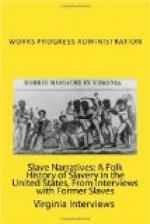“Miss, my name is Isaac Stier, but folks calls me ‘Ike.’ I was named by my pappy’s young Marster an’ I aint never tol’ nobody all o’ dat name. It’s got twenty-two letters in it. It’s wrote but in de fam’ly Bible. Dat’s how I knows I’ll be one hund’ed years old if I lives ’til de turn o’ de year. I was born in Jefferson County ‘tween Hamburg an’ Union Church. De plantation joined de Whitney place an’ de Montgomery place, too. I b’longed to Marse Jeems Stowers. I don’t rightly ’member how many acres my Marster owned, but ’twas a big plantation wid eighty or ninety head o’ grown folks workin’ it. No tellin’ how many little black folks dey was.
“My mammy was Ellen Stier an’ my pappy was Jordon Stier. He was bought to dis country by a slave dealer from Nashville, Tennessee. Dey traveled all de way through de Injun Country on afoot. Dey come on dat Trace road. Twant nothin’ but a Injun Trail.
“When dey got to Natchez de slaves was put in de pen ’tached to de slave markets. It stood at de forks o’ St. Catherine Street an’ de Liberty road. Here dey was fed an’ washed an’ rubbed down lak race hosses. Den dey was dressed up an’ put through de paces dat would show off dey muscles. My pappy was sol’ as a twelve year old, but he always said he was nigher twenty.
“De firs’ man what bought him was a preacher, but he only kep’ ’im a little while. Den he was sol’ to Mr. Preacher Robinson. He was a Methodis’.
“De slaves was well treated when dey got sick. My Marster had a standin’ doctor what he paid by de year. Dey was a horspital building near de quarters an’ a good old granny woman to nuss de sick. Dey was five or six beds in a room. One room was for mens an’ one for wimmins. Us doctor was name Richardson an’ he tended us long after de war. He sho’ was a gent’man an’ a powerful good doctor.
“Us had a overseer on de place, but he warnt mean lak I’se heard o’ other folks havin’. He was Mr. William Robinson. He was good to ever’body, both white an’ cullud. Folks didn’ min’ workin’ for him, ‘cause, he spoke kin’. But dey dassen’ sass ’im. He was poor. My pappy b’longed to his pa, Mr. John Robinson. Dat was a nice fam’ly wid sho’ ’nough ‘ligion. Whilst dey warnt rich, dey had learnin’.
“As a little tike I wore long slip-lak shirts. When dey sont me to town I put on britches an’ stuffed de tail o’ my slip in ’em so’s it pass’ for a shirt. I always lived in de Big House an’ played wid de white chillun. I sorta looked after’ em. I carried ’em to school. Den whilst dey was in school I roamed de woods a-huntin’. Sometimes I’d git a big bag o’ game, mos’ly used to feed de slaves.
“My mistis was Miss Sarah Stowers an’ she teached me how to read. She teached me how to be mannerly, too. On church days I driv’[FN: drove] de carriage. I was proud to take my folks to meetin’. I always set in de back pew an’ heard de preachin’ de same as dey did.




